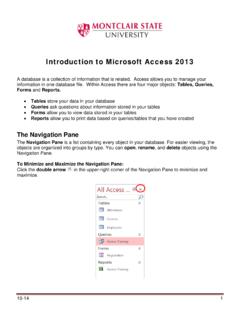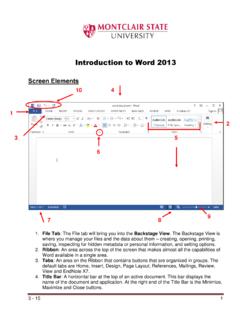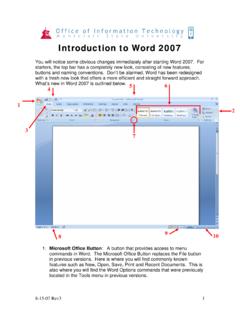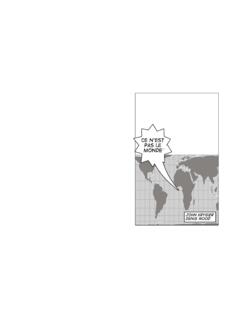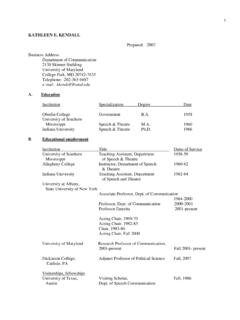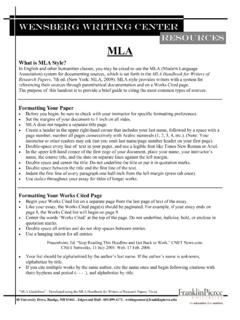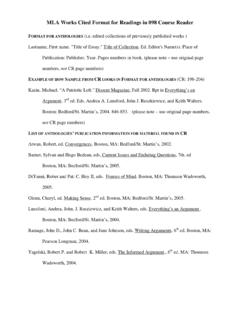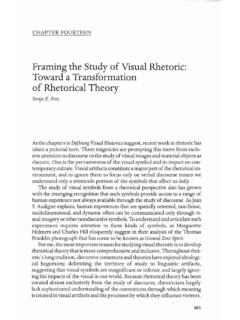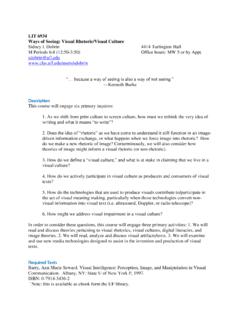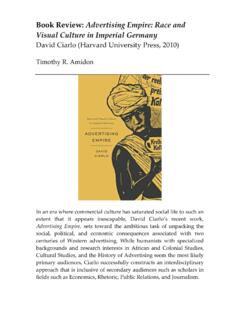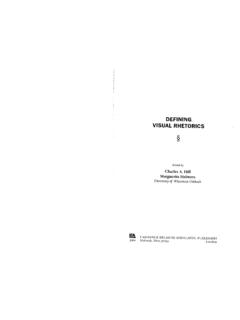Transcription of Visual communication: Images with messages
1 MSU Department of communication Studies Life Hall 050 (973) 655-7471 Visual communication (SPCM 413) Spring 2009 Instructor: Tatyana Dumova, Course: # 14891; Wednesday 5:30 :00 ; Life Hall 051 Contact: tel. 973-655-5480; e-mail Office: Life Hall 055A; Monday 1-3 and Wednesday 8-9 Course Goals & Objectives The major goal of this course is to facilitate students mastery of Visual communication . It examines the theories and practices of Visual communication , principles of Visual persuasion, and Visual communication technologies of the Web era. Course topics include but are not limited to Visual language, semiotics, Visual rhetoric, and visualization strategies for professional communicators.
2 The course is designed to help students prepare for a variety of professional careers where Visual communication competencies are important. In this class students will practice Visual thinking and analysis, engage in collaborative small group projects, document and share their reflective Visual experiences, and produce a series of ePortfolio-ready artifacts to showcase their work. Methods of Instruction Methods of instruction include but are not limited to lecture, small group discussion, self-reflection, sharing of individual and group presentations, group brainstorming sessions, as well as the use of technology enhanced active learning. Textbooks Lester, P. M. (2006). Visual communication : Images with messages .
3 Belmont, CA: Thomson Wadsworth. Jamieson, H. (2007). Visual communication : More than meets the eye. Chicago, IL: Intellect Books. Methods of Evaluation Visual Analysis Paper 20% Visual Exercises (in class) 20% Slidecasting Project 20% Self-Reflection Project 20% Term Group Project 20% 100% Expectations and Policies Grading Policy: A: 94-100%; A-: ; B+: ; B: ; B-: ; C+: ; C: ; C-: ; D+: ; D: ; D-: ; F: Academic Integrity: All students are subject to the code of student conduct, including but not limited to, issues of Academic Honesty and Integrity. If you have any questions about Montclair State University s policy on academic integrity, please contact the Coordinator of Student Conduct at 973-655-4206.
4 Disability Accommodations: Montclair State University is committed to the full inclusion of students with disabilities in all curricular and co-curricular activities as mandated by Section 504 of the Rehabilitation Act of 1973. If you have a disability, please make an appointment to see the instructor. All students will be accommodated to meet their needs. Page 2 of 4 Deadlines: All work must be submitted on time. In-class assignments are due at the end of each class period. For each day a project is late 3% of the grade will be deducted. Department of communication Studies Attendance Policy It is important to understand that you are in charge of your own learning and you share responsibility for your academic achievement and the successful completion of your course.
5 Given the student-driven and collaborative nature of communication Studies classrooms and the general necessity of in-class presence for effective learning, the Department of communication Studies maintains a formal attendance policy, which is applied equally by all professors. Permitted number of absences Students are allowed to miss one week s worth of classes without penalty: two sessions in a twice-a-week course and one session in a once-a-week course. Each absence beyond the permitted number incurs a grade penalty (unless it falls in the excused absences category and proper documentation is provided). Penalties in twice-a-week courses A third absence results in a 5% grade deduction.
6 A fourth absence results in a 10% grade deduction. A fifth absence results in automatic course failure. Penalties in once-a-week courses A second full absence results in a 10% course grade deduction. A third absence results in automatic course failure. Late arrivals Timely arrival at class meetings and appointments is consistent with the workplace expectations that characterize virtually all professions. The Department considers student compliance with this requirement as an indicator of professional commitment and future success. Be aware that three late arrivals to class equal one absence, so timely arrival is very important. Excused absences It is important to reserve the pre-penalty absences for true emergencies should they arise.
7 In cases when true and unavoidable emergencies prevent attendance, such absences may be excused by the instructor. Such excused absences (when properly documented) will not incur grade penalties. They include: a. extended illness; b. death in a student's immediate family; c. call to active military or jury duty; d. away or rescheduled athletic events; e. religious holidays. In such cases, students should be proactive and inform the course instructor as soon as possible. Students should also make appropriate arrangements to submit late required work within a reasonable timeframe determined by the instructor, secure an incomplete grade if the majority of course assignments have been completed (at least 80% of coursework), or withdraw from the course.
8 Unexcused absences The following occurrences do not constitute valid excused absences: late registration; common illness such as cold or flu; scheduled court appearance; traffic or parking problems; participation in home games or athletic training; job interviews; doctor s appointment; family events and celebrations; vacations. Extreme life circumstances In cases of extreme life circumstances, the Department of communication Studies recommends students withdraw from courses so that they may focus their immediate attention on their personal well-being. Doing so will ensure that coursework is conducted at a time when full attention may be devoted to the learning experience. Page 3 of 4 Course Schedule Week Topic Assignments Jan 21 Welcome and Course Overview Introductions, Course Goals, Policies, Readings, and Assignments Jan 28 Visual Perception: Theoretical Perspectives Seeing as Context Readings: J 1; L5 Feb 4 Semiotics: Visual Image as Sign Seeing as Reading Readings: J 2; L 4 (p.)
9 31-49) Feb 11 Processing of Visual Information Audience Perspective Tagging Visual Information Sharing Visual Images Readings: J 2; L 5 Feb 18 Tacit Dimension of Visual communication Tacit Seeing Readings: J 3-4 Feb 25 Aesthetic Dimension Visual Elements and Conventions Readings:J 5; L 5 (Gestalt), L 9 (Contrast, Unity) Mar 4 Ethical Dimension Deception: Visual Manipulation Visual Ethics. Visual Copyright Self-Reflection Project is due Mar 11 Visual Thinking Techniques Reading Visual Images Readings: J 7; L Section 4 (p. 111-120); L 8 Mar 18 Spring Recess, no class Mar 25 Visual Language and Grammar Icons, Logos, and Symbols Readings: L 4, 6, 8-9, 10 (p. 193-194) Apr 1 Visual Narrative Digital Storytelling Readings: L 11 Apr 8 Visual Argument and Logic Visual Rhetoric Readings: L 12 Apr 15 Visualization Tools and Techniques Information Visualization Readings: L 10, 13 Apr 22 Visualization Strategies for Professional Communicators Slidecasting Project is due Readings: L 14 Apr 29 Visual Presentation Technologies Work in Small Groups Readings: L 15, 16 May 13 Final Exam Time: 5:30-7:30 Visual Analysis Paper is due Group Presentations Note: This course schedule is subject to change.
10 Course Assignments Visual Analysis Chose one of the following options: (1) Critically analyze a Visual artifact ( , magazine cover, photograph, advertisement, or website) using Visual communication concepts learned in class. Write your analysis in a 4-5 page essay. (2) Analyze a motion media artifact (such as a TV show, documentary film, motion picture, etc.). Write an essay evaluating the communication value of the visuals. Use the principles learned in class to support your analysis (limit to 4-5 pages). Visual Exercises Page 4 of 4 A series of in-class exercises will offer opportunities to obtain Visual technology competencies and practice critical thinking. The exercises will be due by the end of each class meeting.
